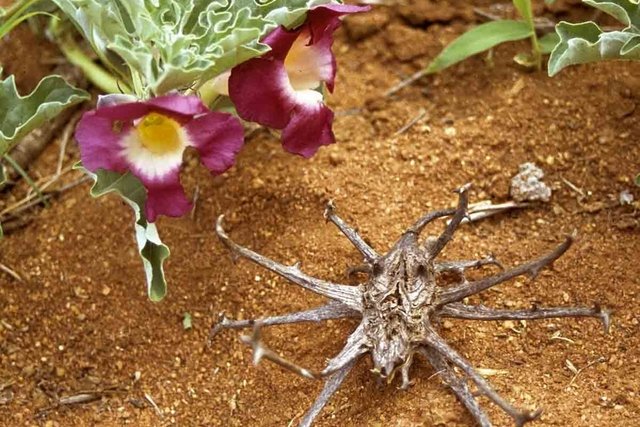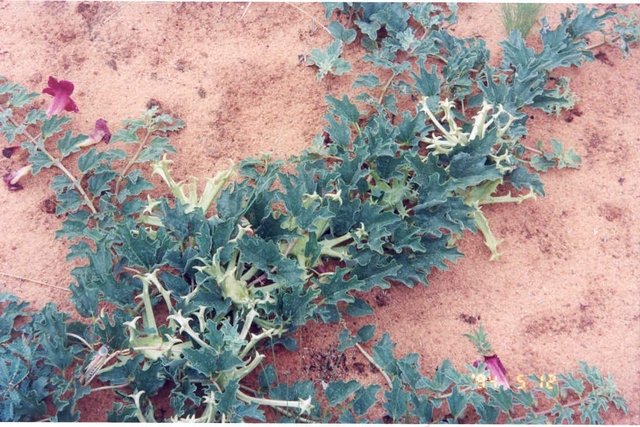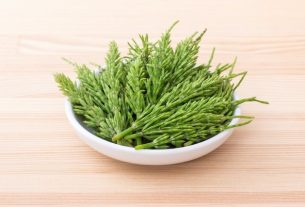Devil’s claw, also known as harpago, is a medicinal plant of the species Harpagophytum prostrate, rich in harpagosides, flavonoids, kaempferol, caffeic acid and chlorogenic acid, with anti-rheumatic, anti-inflammatory, analgesic and antioxidant properties, and is therefore widely used for the treatment of rheumatoid arthritis, osteoarthritis or rheumatism.
The normally used part of devil’s claw is the root, from which active substances with medicinal properties are extracted to prepare tea or capsules.
Devil’s claw can be found in health food stores, compounding pharmacies and in some street markets, and should be used under the guidance of a doctor or other health professional who has experience with the use of medicinal plants.

What is it for
Devil’s claw has analgesic, anti-inflammatory and anti-rheumatic properties, and is normally indicated for:
- Rheumatism;
- Osteoarthritis;
- Rheumatoid arthritis;
- Drop;
- Tendinitis;
- Bursitis;
- Epicondylitis;
- Pain in the spine and lower back;
- Fibromyalgia.
Due to its medicinal properties, devil’s claw can help relieve pain, swelling and redness in the joints, as well as protecting the lining and cartilage of the joints, improving movement and reducing stiffness.
Furthermore, some studies suggest that devil’s claw could also help in the treatment of gastrointestinal disorders, such as dyspepsia, and may also be effective in the case of urinary infections, fever and postpartum pain.
Although it has many benefits, devil’s claw does not replace the treatment recommended by the doctor, being only a complement, and should only be used under the guidance of a doctor or a herbalist.
How to make devil’s claw tea
The part of devil’s claw used is the dried root, from which the active substances, with analgesic, anti-inflammatory and anti-rheumatic properties, are extracted to prepare the tea.
Ingredients
- 1 teaspoon of dried devil’s claw roots;
- 1 cup of water.
Preparation mode
Place the dried devil’s claw root and water to boil for 15 minutes over low heat. Strain and drink 2 to 3 cups of tea per day.
Another option is to use devil’s claw in capsules, the dosage may vary according to the person’s age and purpose of use. Here’s how to take devil’s claw capsules correctly.
Possible side effects
Devil’s claw is considered safe for adults when used for up to 12 weeks of treatment and in recommended amounts. However, when consumed in excess, it can cause side effects such as irritation of the gastrointestinal mucosa, diarrhea, nausea, poor digestion, headache and loss of taste or appetite.
Furthermore, devil’s claw can cause allergic reactions and, therefore, its use should only be done with medical advice or from a health professional with experience in medicinal plants.
Who shouldn’t use
Devil’s claw should not be used by children, pregnant women as it may cause problems in the fetus, or breastfeeding women.
Furthermore, this plant should not be used by people who are allergic to devil’s claw, or who have stomach or intestinal ulcers, gallstones, obstruction of the bile ducts and gastritis.
Devil’s claw should also not be used by people with circulatory or heart problems, or who use anticoagulants, such as warfarin, as it may increase the risk of bleeding.
Bibliography
- Schmidit, I. The Lexicon of Medicinal Plants. 1 ed. Dinalivro, 2007. 130-133.
- WARNOCK, Mary; et al. Effectiveness and safety of Devil’s Claw tablets in patients with general rheumatic disorders. Phytotherapy Research. 21. 12; 1228-1233, 2017
- COSTA, E. Nutrition & Phytotherapy. 2ed. Brazil: Vozes Ltda, 2011. 151-152.
- Monograph of the species Harpagophytum procumbens DC. from Meissen (“claw-do-devil”). Monograph, 2015. Ministry of health and ANVISA.
- GRUNWALD, JORG; JANICKE, CHRISTOF. The green pharmacy. Spain: Editora Everest, 2009. 364-365.
- MYRALIS PHARMA. Bioflan – Harpagophytum procumbens. 2014. Available at: <http://media.netfarma.com.br/bulas/Bioflan-30-P00029MYL00.pdf>. Accessed on June 12, 2019
- BVS. What is the evidence for the use of Devil’s Claw in Primary Health Care?. Available at: <https://aps.bvs.br/aps/quais-as-evidencias-para-o-uso-de-garra-do-diabo-na-atencao-primaria-a-saude/>. Accessed on 17 December 2020
- MENGHINI, Luigi; RECINELLA, Lucia; LEO, Sheila; CHIAVAROLI, Annalisa; et al. Devil’s claw (Harpagophytum procumbens) and chronic inflammatory diseases: A concise overview on preclinical and clinical data. Phytother Res. Vol 33. 9 ed; 2152-2162, 2019
- BRIEN, Sarah; LEWITH, George T.; MCGREFOR, Gerry. Devil’s Claw (Harpagophytum procumbens) as a Treatment for Osteoarthritis: A Review of Efficacy and Safety. The Journal of Alternative and Complementary Medicine. Vol 12. 10 ed; 2007

Sign up for our newsletter and stay up to date with exclusive news
that can transform your routine!
Warning: Undefined array key "title" in /home/storelat/public_html/wp-content/plugins/link-whisper-premium/templates/frontend/related-posts.php on line 12
Warning: Undefined array key "title_tag" in /home/storelat/public_html/wp-content/plugins/link-whisper-premium/templates/frontend/related-posts.php on line 13




